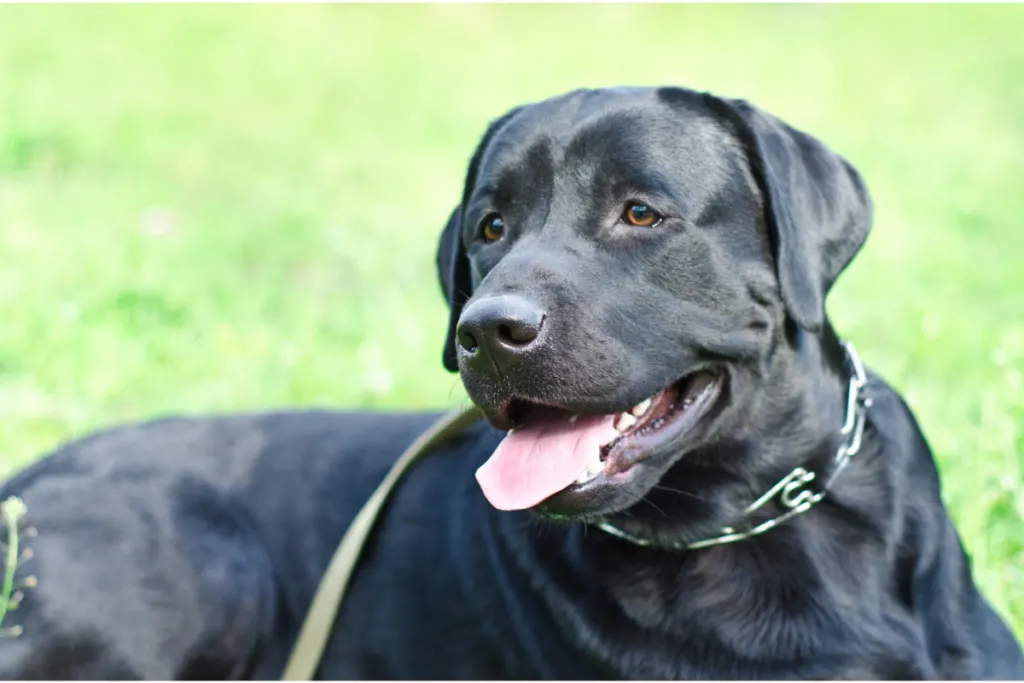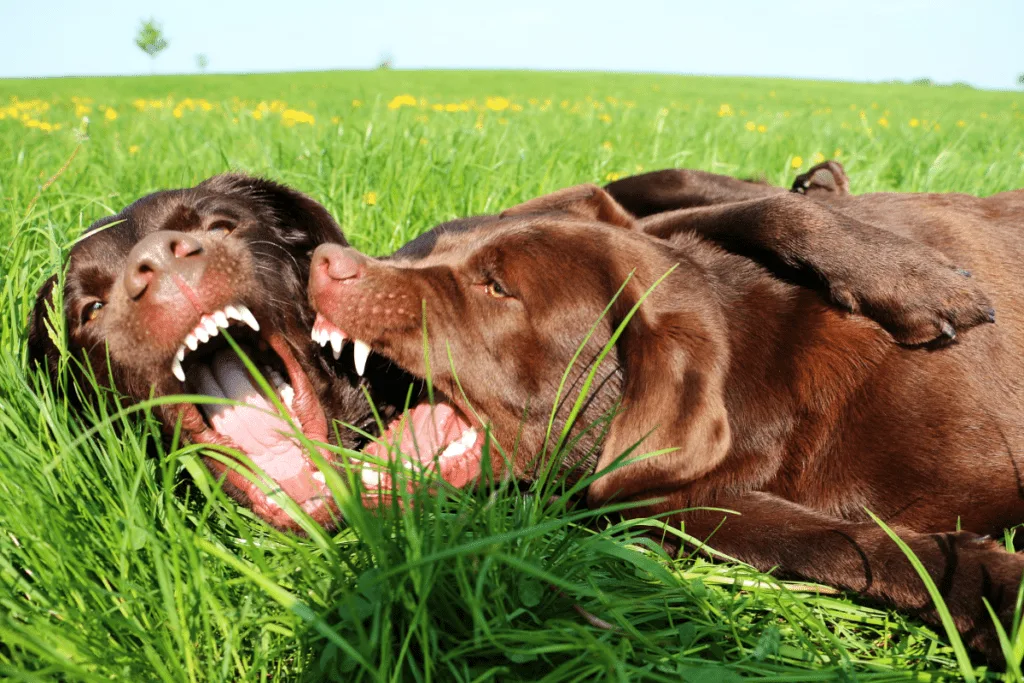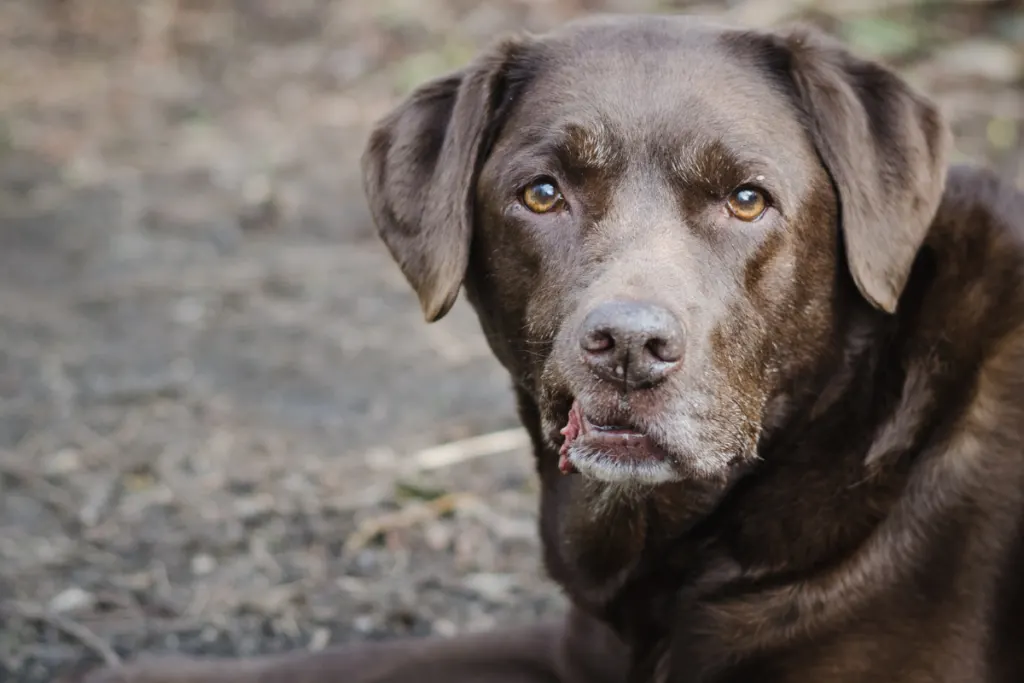The benefits of owning a Labrador are manifold and include decreased stress levels, increased happiness, companionship and many more.
However, every Labrador features a set of pearly white, sharp-edged teeth that can cause significant damage to humans, dogs and other animals in the event of a bite.
Labradors may bite if:
- Provoked, e.g., teasing, taunting, hurting & cornering the Labrador etc.
- They’re in pain
- They’ve aggressive/anxious temperaments
- Disease processes causing increased aggression
- Protective, territorial & resource guarding
- Accidental biting
- Hormone-linked aggression

Labrador bites have significant consequences for humans and the involved dog.
The bitten person may need medical care, suffer from permanent scarring or develop an infection or disease as a result of the bite.
The dogs who have bitten a person are more likely to be abandoned, handed over to a shelter (i.e., rescue organization) or rehomed. Nobody wins when a Labrador bites a person!
Click Here to Jump to a Section
Reasons A Labrador Would Bite
Labradors have been the most popular USA dog breed for over 30 years; their winning streak has been unbroken since 1990!
Their popularity is well-earned; they’re happy-go-lucky, friendly, trainable dogs marketed as the ideal family dog.
However, regardless of the Labradors’ justified reputation as an excellent companion dog, Labradors will bite in certain circumstances.
Labrador bites are divided into 3 categories:
- Provoked versus unprovoked
- Accidental versus purposeful
- Nonserious nipping versus uninhibited biting
(Source: AKC)
What Is Considered A Provoked Bite?
ALLLaw has provided a helpful explanation of what is considered a provoked bite versus a non-provoked bite.
The legal definition is somewhat more complex, but at its essence, a provoked bite is a dog that bites a person as a direct result of something happening to that dog.
Intentional actions that are considered legal provocations include:
- Teasing, taunting and prodding the Labrador
- Cornering a frightened Labrador or physically abusing them
- Restraining a fearful, anxious or dominant dog
- Letting your child take food from the dog’s mouth, sit on them or jump on them, i.e., demonstrating behaviours that do not respect the Labrador’s comfort level.
Unintentional actions that are considered legal provocations include:
- Little kids tripping and falling on the Labrador
- Accidentally putting an object down on the Labrador’s tail
An unintentional provocation indicates any act that provoked the Labrador to bite but was not intended to cause physical or emotional distress.
Legal liability is often limited in cases where the bite was provoked; however, each case of dog aggression should be assessed on an individual basis and advice sought from an appropriate legal representative.
Why Is Unprovoked Biting More Dangerous Than Provoked Biting?
Unprovoked biting is significantly more dangerous than provoked biting because there was no reason to justify the Labrador’s behaviour; in these cases, the owners will have minimal to no legal defence.
Labradors may exhibit unprovoked biting if they:
- Have an unstable temperament
- Are in physical pain
- Exhibit learned behaviours
- Display protective instincts,
- Are infected with a disease, causing aggression
Labradors With Unstable Temperaments

The popularity of the Labrador has resulted in an explosion of unregistered, non-standard Labradors.
Labrador’s who do not adhere to the breed standard or come from reputable breeders are more likely to suffer from temperament issues that often include increased aggression or anxiety.
These Labradors are still good dogs and can learn to be balanced, reliable dogs if placed in an experienced home.
However, they will have a higher lifetime risk of being involved in a biting incidence than a Labrador with the “true AKC Labrador temperament.”
The AKC recommends that any Labrador who shows aggression or extreme shyness be automatically eliminated from any breed show and breeding program.
Hormonally linked aggression is more common in intact males and females during their heat.
These Labradors may have good basic temperaments that are negatively affected by fluctuating hormone levels.
Breeders should avoid using these Labradors in their breeding programs. However, once sterilized, many of these Labradors become reliable, safe pets.
Physical Pain Can Trigger Bites
Labradors in pain may lash out in “self-defence” and bite a person in an unprovoked attack.
Although their reason for biting is understandable, the provocation did not originate with the bitten person.
Specific disease processes or injuries will cause extreme pain, and the Labrador will react defensively in an attempt to get away and avoid further pain.
Examples of pain-elicited biting are:
- Chronic pain: An arthritic Labrador who cannot move quickly may have learned that children routinely bump or hug him, causing extreme pain. The dog starts pre-emptively growling when they see the child approaching them and may back up their warning with a bite.
- Acute pain: A Labrador with a fractured leg is carried to the car to go to the vet. This Labrador may be so frightened and hurt that they react instinctively like a wild animal and fight to defend themselves.
Labradors Can Learn To Bite
Labradors will learn to bite if biting gets them the outcome they want. This learned behaviour is typical in resource guarding, where a dog protects and defends anything they consider “theirs”.
Initially, the Labrador will start growling to warn the person away but will escalate to biting if the person ignores the Labrador’s warnings.
Owner’s dealing with these Labradors should seek professional help as soon as the behaviour presents itself.
Resource guarding is easy to manage if addressed early; however, the Labrador will be harder to retrain if the behaviour is ignored and reinforced.
Protective Behaviour Is Natural For A Pack Animal
While Labradors are one of the least aggressive dog breeds, they will still react to defend their owner, their pack mates and their puppies if forced.
Protective behaviour may result in a provoked or unprovoked dog bite.
An example of an unintentionally provoked attack would be:
Imagine two people fighting (one of which is the Labrador’s owner), and the other person begins shouting, acting aggressively and pushing the owner around.
Should the owner fall or exhibit behaviour indicative of distress, the Labrador may bite the aggressor in defence of their owner.
A bite event like this is unintentional but still provoked. The aggressor in the argument did not direct their actions towards the Labrador but acted in a way that triggered the Labrador’s natural protective instinct.
An example of an unprovoked protective attack would be:
A trained protection dog who misreads a situation and attacks an innocent person performs an unprovoked protective attack.
Although Labradors are not the preferred dog for personal protection work, some Labradors have been trained to perform this function.
The video below is an excellent example of a Labrador trained for protection work:
Labradors may also display territorial aggression, but it is considered an unprovoked attack if the Labrador bites a person who stuck their hand through the fence or opened the yard gate.
While the person’s actions were not wise, they also are not classified a provocative.
Disease Processes Causing Increased Aggression
Certain diseases cause symptomatic changes in a Labrador’s behaviour, which may include elevated aggression.
The most well-known virus to result in heightened aggression in infected individuals is the Rabies Virus that causes acute encephalomyelitis.
Encephalomyelitis refers to the rapid swelling of the brain and other neural tissues. The Rabies virus is transmitted via the saliva of infected individuals during a bite attack.
Hormones play an influential role in regulating a Labrador’s base levels of aggression, and serotonin is one of the neurotransmitters (hormones acting in the brain’s neuronal synapses) that modulates the aggression levels in Labradors.
There are two regions of raphe nuclei in the brain, the median and the dorsal raphe regions.
The median raphe region is responsible for inhibiting aggressive behavioural responses, whereas the dorsal raphe region has been linked to social or affiliative behaviours.
The Rabies virus accumulates in the midbrain raphe nuclei, inhibiting (i.e., stopping) serotonin neurotransmission between the brainstem and other neural structures.
The altered serotonin levels disrupt neural signalling in these brain regions and cause increased aggression and reduced social behaviours.
Eventually, the neural injury caused by the disease will lead to the Labrador showing pathologically elevated levels of aggression.
The Rabies virus promotes viral transmission through the stimulation of aggression-linked biting.
It is not the Labrador’s fault that they become so aggressive, but a bite from a rabies-infected dog is exponentially more dangerous than a “standard” dog bite.
The Rabies virus is virtually 100% fatal, and Labradors infected with rabies must be handled with extreme caution before being euthanized.
(Source: National Library of Medicine; Genes, Brain and Behaviour; Frontiers of Behavioural Science)
Accidental Versus Purposeful Biting

Although the Labrador’s intentions behind the bite do not minimize the bitten person’s pain, they affect how the owner should address the Labrador’s behaviour.
Not all dog bites are intentional; while people who are not familiar with dogs may shake their heads in disbelief, the truth remains: sometimes circumstances arise that cause a Labrador to bite a person mistakenly.
For example:
Another dog (e.g., English Bullmastiff) attacks a Labrador going on a walk with its owner, forcing the Labrador into a fight (not of his own making) in which he must fight for his life.
The owners of the dogs and helpful bystanders may try to separate the dogs, and in the process, the Labrador, who is in an adrenaline-fuelled state, bites the person’s hand.
A study published in 2014 found that 24% of all dog bites were due to people attempting to separate fighting dogs.
Labradors may also accidentally nip or bite someone if overexcited during play or struggling with visual problems.
Older Labradors with impaired vision may accidentally nip their owners’ fingers when being hand-fed.
Purposeful biting is when the Labrador knows who they are biting, e.g., a resource guarding Labrador who bites their owner when attempting to take away the Labrador’s toy.
(Sources: Zoonoses)
The Severity Of A Nip Versus A Bite
A Labrador who nips typically makes contact with their front teeth and rarely breaks the skin, although a minor bruise may develop.
Nipping behaviour is generally linked with accidental bites, e.g., impaired vision, as described previously.
Nipping is often seen in puppies and juvenile Labradors as they play and explore the world.
While this behaviour is not dangerous, it should be gently and firmly corrected to prevent future problems.
By contrast, a bite involves the whole (or most of the mouth) and is more frequently associated with significant trauma.
A bite may be inhibited in which the Labrador regulates the force of the bite (e.g., during play) or uninhibited when they bite as hard as they can.
Bites are more forceful, cover a larger area and are often accompanied by shaking of the head, ripping and tugging during the event of a bite.
Bites may be aggressive or non-aggressive but should always be taken seriously due to the amount of physical and emotional discomfort that a dog bite can cause.
Recognizing The Signs Of An Eminent Dog Bite

Many Labrador bites are avoidable if people learn to recognize the non-verbal signs of aggressive, anxious and fearful dogs. These signs include:
- Growling, showing teeth or snarling (i.e., growling and showing teeth)
- Avoiding humans and trying to leave the area
- Raised hackles, i.e., the hair along their back stands up
- Stiff posture with direct eye contact and raised tail, the Labrador may also hold themselves very still before lunging
- Cowering, tucking their tail between their legs and hiding away
- Whale eye, i.e., when the dog rolls the eye showing the whites of it
- Charging that may be accompanied by barking
- Gutteral barking
- Lunging
- Bumping with their nose, mouthing and nipping
- Yawning, blinking rapidly and turning their head away from the person or averting their gaze
What To Do If You Own A Labrador Who Bites
Biting behaviour should never be dismissed or disregarded. All dog owners should educate themselves on:
- Understanding canine ethology, i.e., dog behaviour
- How to teach their Labrador to be polite, socially acceptable, and, more importantly, safe when around humans and other dogs
- How to behave politely and confidently around Labradors and thus respect their Labrador’s comfort levels and non-verbal communications, i.e., never provoke a bite.
- Being effective and safe when working and interacting with their Labradors
A vet should see labradors who have bitten someone or have developed a habit of biting to rule out physical reasons for the biting.
Once the vet has ruled out physical causes, a vet-recommended dog behaviourist can assist owners in developing and implementing a strategy to help address their Labrador’s biting behaviour.
The behaviourists will work on helping the Labrador and educating the owners on how their behaviour can trigger or even worsen biting and aggression in their Labrador.
Final Thoughts
Any dog, even a mild-mannered Labrador, will bite in the right circumstances.
Biting should never be ignored or laughed at as it can have severe consequences for the following:
- The Labrador
- The person bitten
- The owner, if a third party is involved
